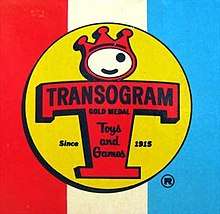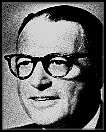Transogram
Transogram was an American producer of toys, games and other leisure products from the early 20th century to 1971. It is best known for such long-produced games as Tiddledy Winks and Game of India, as well as such baby-boomer favorites as Green Ghost and television tie-in board games for such characters and series as Atom Ant, The Flintstones, Gomer Pyle, U.S.M.C., Perry Mason and Tom and Jerry.
 | |
| Fate | Bankrupt 1971 |
|---|---|
| Founded | 1915 |
| Founders | Charles Raizen |
| Defunct | 1971 |
| Headquarters | , |
Key people | Charles Raizen, Roy Raizen, Jerry Tolk |
| Products | Toys, board games, jigsaw puzzles |
History
Early years
Around the turn of the 20th century, Charles Raizen took a summer job with a manufacturer of embroidery patterns.[1] Years later, he found a method of transferring images using friction, and circa 1915, the company became the Friction Transfer Pattern Company,[2][3] first located on 2nd Street, between Avenues C and D, in Manhattan,[4] then at 113-115 University Place.[5][6] It quickly found that children enjoyed transferring the friction patterns, and the company shifted toward children's products such as Art-Toy Transfer Pictures. In 1917, Raizen bought the company and renamed it Transogram,[3] but using 1915 as the founding date in its company logo (see above). Moving to 200 Fifth Avenue,[7] the company developed the Toy Research Institute in order to test toys with input by a child psychologist, leading to the 1920s tagline that its toys were "Kid Tested".[3] The company also began licensing media properties, manufacturing the likes of a Little Orphan Annie set of clothes pins.
After producing toys, play sets and activity items, the company in 1929 produced its first game-like product, Orje, The Mystic Prophet, which one historian calls "a solitaire fortunetelling pastime".[3]
In early 1939, the company announced that its new game Movie Millions would have a marketing push, headed by advertising manager Lee Sheldon, in magazines, trade magazines, newspapers and radio.[8]
Later years
In 1955, Transogram introduced its first TV-series licensed board game, Dragnet.[3]
In 1960, Transogram was one of seven toy-makers, including Ideal and Parker Brothers, that the Federal Trade Commission accused of violating antitrust law by allegedly soliciting discriminatory advertising allowances from suppliers.[9]
Transogram advertised on television in 1968 for the first time in six years, with a million-dollar campaign centered on Green Ghost and Hocus Pocus, its two glow-in-the-dark games; Kabala, a future-telling game; and the printing kit Inkless Printing. The TV commercials were produced by the advertising agency Smith / Greenland.[10]
Going public and final years
Following a previous incorporation in New York, the Transogram Company incorporated in Pennsylvania on September 4, 1959.[11] In May 1962, Transogram made an initial public offering of 196,000 shares of common stock from Charles Raizen's private account. It sold for US$10 a share. Raizen retained control with 61.4 percent of outstanding stock.[11][12]
In 1966, Transogram's total sales were $18,665,631.[13] In the first six months of 1967, the company posted a loss of $1,191,000 on sales of $4,713,000, down from $6,169,000 in sales during the same period the year before. For the first nine months of 1970, Transogram reported a loss of $2,328,000 on sales of $21,642,000, compared to a loss of $293,000 on sales of $17,938,000 during the same period in 1969.[14] Transogram announced in August 1969 that it had agreed to acquire 81 percent of the stock in Mountain Savings and Loan of Boulder, Colorado, in exchange for an unspecified number of shares of Transogram stock.[15]
The financial holding company Winthrop Lawrence, controlled by du Pont heir Lammot du Pont Copeland Jr. and Thomas A. Sheehan, bought controlling interest in Transogram in 1969 and installed Joseph Bruna as chief executive officer. On February 26, 1971, Transogram declared Chapter 11 bankruptcy, listing liabilities of $12,067,307 and assets of $3,009,072. Trading on the American Stock Exchange had been suspended the week prior.[16]
The Transogram trademark and assets were liquidated in 1971, with the marks and toy molds purchased by Jay Horowitz of American Plastic Equipment, who later transferred all rights to American Plastic Equipment's subsidiary, American Classic Toys. In 2019, American Classic Toys entered into an exclusive license agreement with The Juna Group to represent the Transogram brands in all categories, worldwide.
Products
Board games
|
Licensed film & TV board gamesSource unless otherwise noted:[3]
Other
|
Subsidiaries and manufacturing plants
|
Source unless otherwise noted:[11]
|
Divisions
Manufacturing plants
|
Personnel
Al Capp, prior to his success as the cartoonist creator of the comic strip Li'l Abner, was a graphic designer for Transogram.[3]
By mid-1948, Harold Ross, formerly of Kermin, Thall and Lavelle, had joined as advertising art director.[26] In 1956, Jack Arnold, former advertising manager of Saxon Paper Corp., joined Transogram as advertising manager.[27]
By 1968, Jerry Tolk was executive vice president of Transogram.[28]
Founder Charles S. Raizen

Company founder Charles S. Raizen (1892-1967)[1] and his wife Patricia Tolk[25] were living in New Rochelle, New York, in 1958 when their son Roy R. Raizen became engaged. A graduate of the Salisbury School in Connecticut and of Lafayette College, and a U.S. Army first lieutenant who had been stationed in Europe, Roy Raizen was a vice president of Transogram at the time.[29] In 1964, he was elevated from executive vice president in charge of operations to president. succeeding his father, who became chairman.[30] The couple additionally had a daughter Edna Mae.[25]
Charles Raizen, who served a stint as president of the Toy Manufacturers of the US, was residing at 309 Beechmont Drive in New Rochelle when he died on May 13, 1967, age 74, at the Plaza Hotel in Manhattan while attending a charity dinner.[25] He was elected posthumously to the Toy Industry Hall of Fame in 1986.[31]
References
- Charles Raizen entry at the Toy Industry Association's Toy Industry Hall of Fame. Archived from the original on April 12, 2017.
- Paul, Larry R. (2005). Made in the Twentieth Century: A Guide to Contemporary Collectibles. Scarecrow Press. p. 230. ISBN 978-0810845633.
Transogram Toys Pre-1915 Began as Friction Transfer Pattern.
- Whitehill, Bruce. "Transogram". TheBigGameHunter.com. Archived from the original on May 4, 2020. Retrieved December 16, 2017.
- "Department of Manufacturers and Varied Industries > Group 75". Official Catalogue of Exhibitors. San Francisco, California: Panama-Pacific International Exhibition. 1915. p. 29.
Friction Transfer Pattern Company.
- "New York Trade Notes". The American Stationer. March 11, 1916. p. 11.
- "Decalomania". The Reference Register. New York City: White, Orr & Company. 1918. p. 138.
- "Plastic Modeling Intrigues Children". The New York Times. July 24, 1956. p. 28. Retrieved December 16, 2017. (abstract; full article requires subscription)
- "News and Notes of the Advertising Field". The New York Times. February 3, 1939. p. 34. Retrieved December 16, 2017. (abstract; full article requires subscription)
- "Toy Makers Accused". The New York Times. Associated Press. July 4, 1960. p. 44. Retrieved December 16, 2017. (abstract; full article requires subscription)
- Smith, William D. (August 23, 1968). "Advertising: Holiday Gets a New Publisher > Transogram on TV". The New York Times. p. 56. Retrieved December 16, 2017. (abstract; full article requires subscription)
- "Transogram Company, Inc". Harvard Business School, Lehmann Brothers Collection — Contemporary Business Archives. Retrieved December 14, 2017.
- Note: It was not listed a recent issue in The New York Times until August. "Recent Issues". The New York Times. August 29, 1962. p. 56. Retrieved December 16, 2017. (abstract; full article requires subscription)
- Metz, Robert (September 15, 1967). "Market Place:; Transogram In Big Play". The New York Times. p. 75. Retrieved December 16, 2017. (abstract; full article requires subscription)
- "Continental Telephone Raises Profits". The New York Times. November 19, 1970. p. 88. Retrieved December 16, 2017.
- Hammer, Alexander R. (August 2, 1969). "Travelers Seeks Randolph Computer". The New York Times. p. 40. Retrieved December 16, 2017. (abstract; full article requires subscription)
- Jensen, Michael C. (February 27, 1971). "Bankruptcy Filed by Transogram". The New York Times. p. 34. Retrieved December 16, 2017. (abstract; full article requires subscription)
- "[Advertisement: 'Transogram Score a Word']". The Pocono Record. Stroudsburg, Pennsylvania. December 3, 1954. p. Page 28. Retrieved December 17, 2017.
- Mansour, David (2005). From Abba to Zoom: A Pop Culture Encyclopedia of the Late 20th Century. Andrews McMeel Publishing.
- "'Paint-by-Number' Sets Appear in New Version". The New York Times. February 12, 1959. p. 31. Retrieved December 16, 2017. (abstract; full article requires subscription)
- Kovalchik, Kara (July 6, 2009). "7 Dangerous Toys Kids Today Are Missing Out On". MentalFloss.com (Dennis Publishing). Archived from the original on June 16, 2017. Retrieved December 19, 2017.
- "Myrna Margulies Planning Nuptials". The New York Times. January 20, 1970. p. 33. Retrieved December 16, 2017.
- By 1936, the Transogram subsidiary the National Assembly Company moved to the Karpen Building at 37-08 Northern Boulevard in the Long Island City neighborhood of the New York City borough of Queens, per "Canadian Agency Moving". The New York Times. August 20, 1936. p. 35. Retrieved December 16, 2017. (abstract; full article requires subscription)
- "Retail Buyers Look at Op and Pop Art". The New York Times. May 18, 1965. p. 53. Retrieved December 16, 2017. (abstract; full article requires subscription)
- In October 1962, Transogram announced that it in order to better integrate its Playwood Plastics Company subsidiary, the company had added 90,000 square feet to its toy and juvenile-furniture manufacturing facility in Sturgis, Michigan, per "Expansion of a Toy Plant Completed by Transogram". The New York Times. October 14, 1962. p. 160. Retrieved December 16, 2017. (abstract; full article requires subscription)
- "Charles Raizen of Toy Company". The New York Times. May 15, 1967. p. 43. Retrieved December 16, 2017. (abstract; full article requires subscription)
- "Advertising News and Notes". The New York Times. August 13, 1948. p. 24. Retrieved December 16, 2017. (abstract; full article requires subscription)
- "Advertising & Marketing". The New York Times. August 10, 1956. p. 28. Retrieved December 16, 2017. (abstract; full article requires subscription)
- "Ellen Tolk Fiancee Of Joseph I. Burke". The New York Times. March 3, 1968. p. 35. Retrieved December 16, 2017. (abstract; full article requires subscription)
- "Nancy F. Barovick Prospective Bride". The New York Times. March 16, 1958. p. 100. Retrieved December 16, 2017. (abstract; full article requires subscription)
- "Transogram Elects President". The New York Times. June 27, 1964. Retrieved December 16, 2017.
- Toy Industry Hall of Fame at the Toy Industry Association. Archived from the original on April 12, 2017.
External links
- Transogram Company print advertising at Magazine-Advertisements.com. Retrieved on December 17, 2017.
- Charles Raizen interview on his views on toy industry, in Auerbach, George (July 5, 1953). "Big Year Forecast for Toy Industry". The New York Times. p. 88. Retrieved December 16, 2017. (abstract; full article requires subscription)